Book Recommendations for New Perspectives
As the weather gets warmer, few things are more alluring than hunkering down in the shade of a pitch pine and reading a good book. If that sentiment is true for you, then perhaps you’d be interested in some off-kilter book recommendations. The selection of books below seeks to be a collection of tales that look at the natural world from different perspectives than you might be used to, and will hopefully give you a newfound appreciation and respect for our wondrous planet.
Recommendation #1: The Histories by Herodotus
Hear me out on this. I’m sure that the first question that popped into your head was “Why a history book recommendation from an environmental nonprofit? Let alone the first ever history book…” Well, that’s just it: despite the title, Herodotus’s classic isn’t just a history book. In writing about the conflict between the ancient Greeks and Persians, Herodotus set the stage by describing in exhaustive detail all the civilizations that he knew about. Thus, the first half of the book reads more like a travelogue, with intricate details provided about the history, culture, and, yes, the environment of the places discussed. From the lush floodplains of the Nile to the barren steppes of the Caucuses, Herodotus paints a vivid (albeit, often embellished) portrait of a world so far removed from our own, yet very akin to it in many ways. If nothing else, Herodotus is a master of empathy, and we could all use a bit more of that in this day and age.

A mountain peak in Ushguli, Georgia. Photo courtesy of Wiley Wilkins, via Unsplash.
Recommendation #2: Butcher’s Crossing by John Williams
This book is perhaps the greatest argument in favor of the “humans should leave nature alone” case ever written. A rebuke of Emersonian transcendentalism, Butcher’s Crossing tells the story of a young man who drops out of Harvard so that he can travel out west to find God. He signs himself up as part of a buffalo hunting crew, and from then on, the book is a never-ending barrage of trauma and hardship, all of it ultimately caused by human greed and the need to assert dominance over the natural world. This book is many things: a western; a critique of human expansionism; a portrait of both the transcendent beauty and the awe-inspiring destructive power inherent in the natural world. It’s a book that ultimately forces self-reflection, and a newfound respect for the world beyond the walls. Be warned, though! This book is not for the squeamish. Guts and gore aplenty, so be wary.
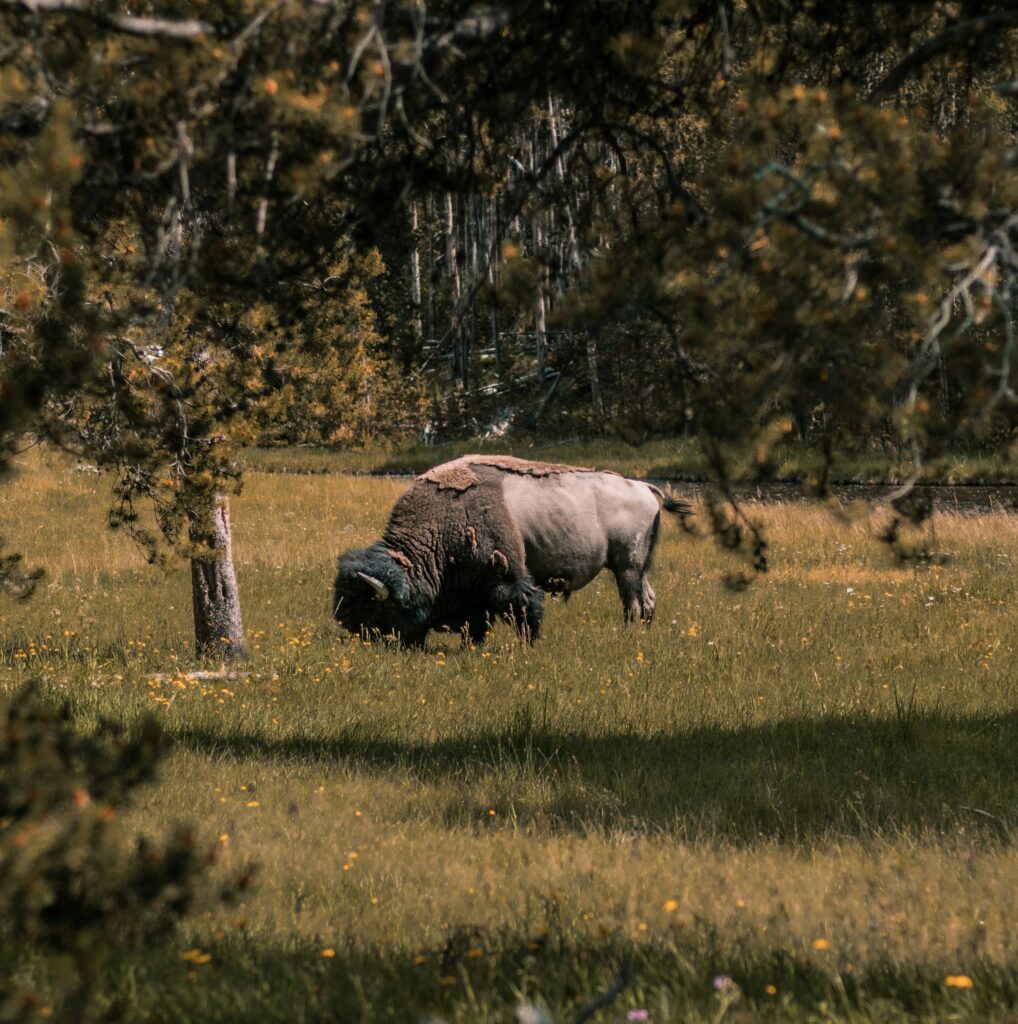
Buffalo. Photo Courtesy of Romain De Moor via Unsplash.
Recommendation #3: Eye of the Albatross by Carl Safina
Odds are, if you’re a dedicated enough conservationist that you read this blog, you’ve heard of Carl Safina. A year ago, in fact, Board Secretary Nina Leonhardt recommended one of his recent releases, Beyond Words: What Animals Think and Feel, but for this list it only seems appropriate to recommend Carl’s debut work. Eye of the Albatross gives the reader a new perspective, in the most literal sense possible, by following the life of an albatross over the course of a breeding cycle. The life of an albatross, it turns out, is filled with just as many trials and tribulations as the life of a human being. After reading this book, you’ll never look at a bird – or, hopefully, any animal – the same way again.
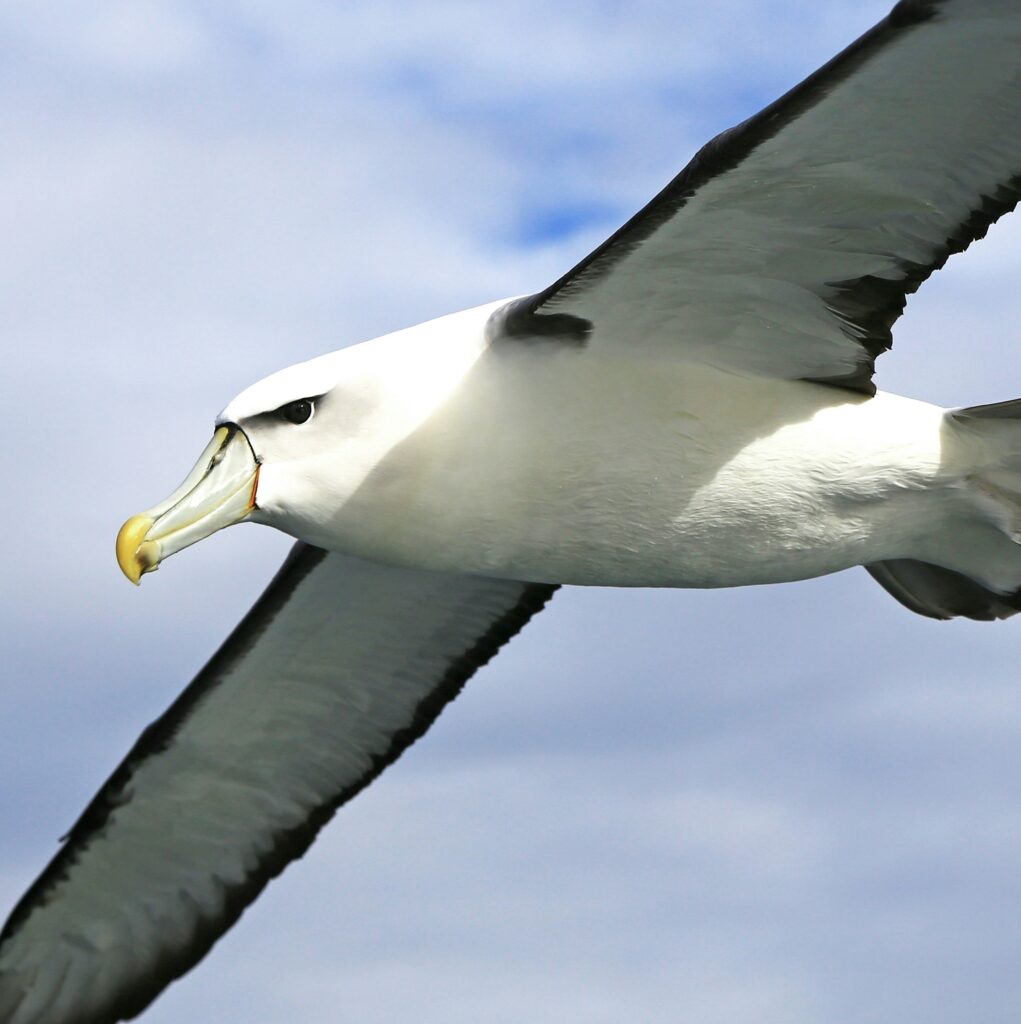
An albatross. Photo courtesy of Nareeta Martin via Unsplash.
Hopefully at least one of these recommendations suits your fancy this spring! With the world around you reviving after the cold, dreary winter, there’s no better time than to give yourself a new outlook on life, and books are a great way to do that.
By Travis Cutter, Long Island Pine Barrens Society
Cover Image courtesy of USGS via Unsplash.
Posted on April 20, 2024 by Long Island Pine Barrens Society
A Beginner’s Guide to Bird Identification
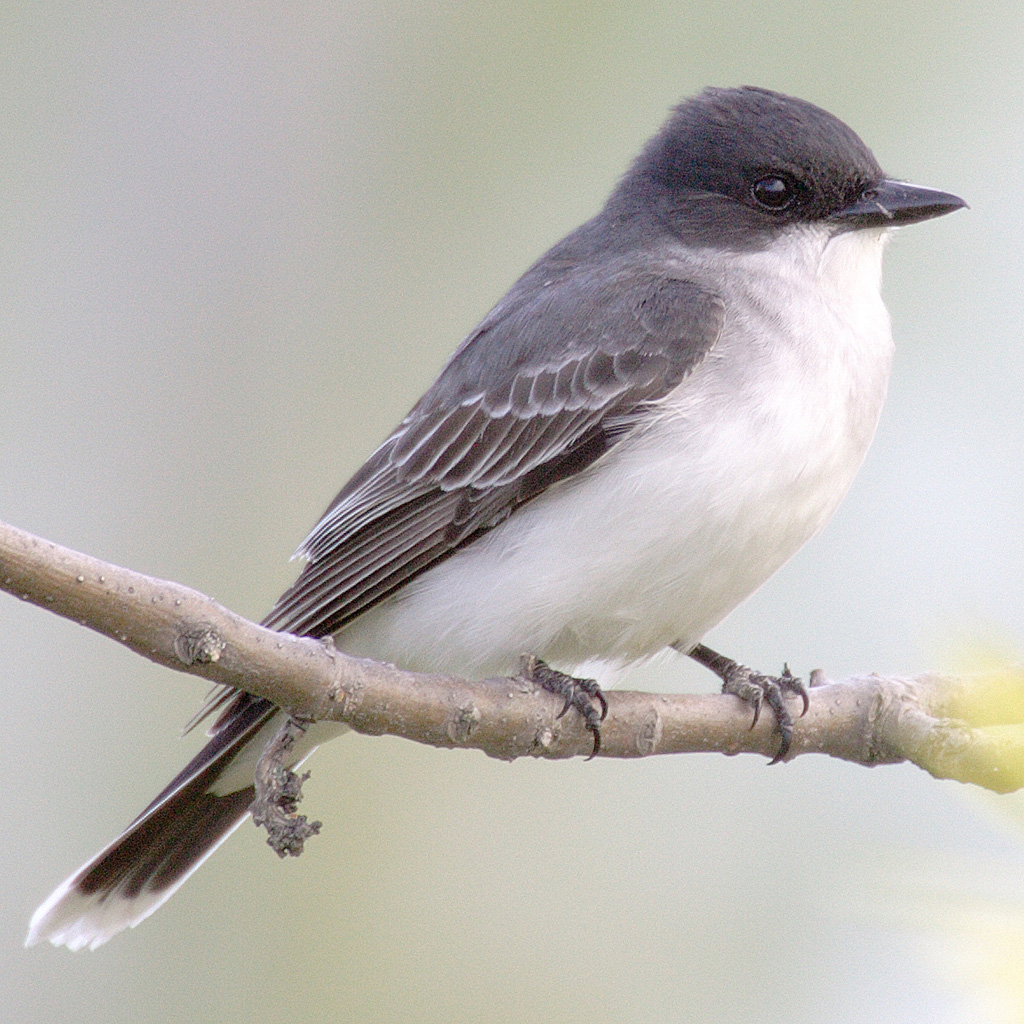
For many, birds are the highlight of their time in the Pine Barrens. Yet, even after years of casual birding, it can be difficult to distinguish certain species from one another. That is, of course, if you don’t know what traits to look for. Here, I’ll present for your viewing pleasure some of the more confounding common birds, and how I’ve learned to tell them apart after four years of birding.
Downy and Hairy Woodpeckers
Let’s start with a deceptively simple one. At a glance, the Downy and Hairy Woodpeckers look like they’re the same species, especially at a distance. While the animal’s overall size is usually a good clue as to what species you’re looking at, there are times when this just won’t cut it. The smallest Hairy and the largest Downy could easily appear to be one another! When you’re unsure, the easiest solution is to look at the size of the bird’s beak, and more specifically its size in relation to the animal’s head. If the beak is much smaller than the bird’s head, it’s a Downy. If the beak is as long as or longer than the bird’s head, it’s a Hairy!
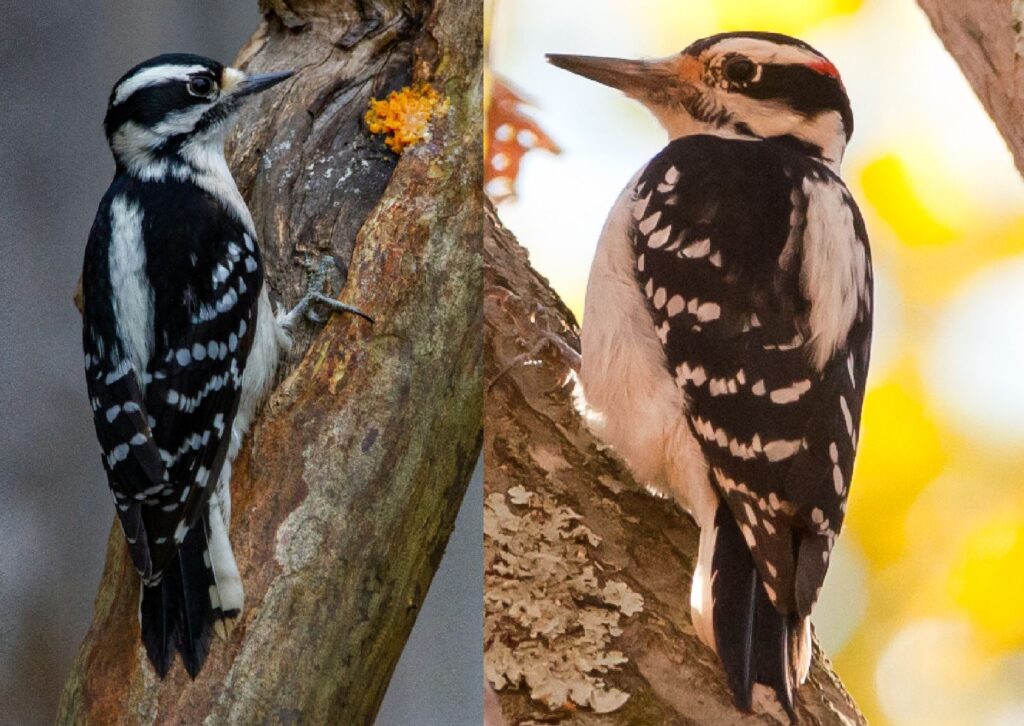
Left: A Downy Woodpecker. Right: A Hairy Woodpecker. Photo Credits: Joshua J. Cotten (via Unsplash) and Daniel D’Auria
Yellow and Pine Warblers
Did you know that many of the most common warblers you’ll see around Long Island all belong to the same genus. Yellow, Pine, and Yellow-rumped warblers, among others, all belong to the genus Setophaga. For reference, when we talk about dinosaurs, we generally only refer to an animal’s genus, as distinguishing between species is often too difficult! This holds true with modernity’s warblers, which often possess similar, if not identical, silhouettes. However, with decent lighting, most of the more common species are simple enough to distinguish from one another thanks to their varied plumage patterns. Even with the often-extreme sexual dimorphism present in many warblers, the males and females of a given species are often distinct from any other species you’ll find in a similar habitat (though the drabber females will likely require a closer look to properly identify). However, Yellow and Pine Warblers are an exception to this: they’re both predominantly yellow in coloration and possess darker wings and streaks on their bellies. Ultimately, there are three key features you can use to distinguish the birds. First, are their wings. While Yellow Warblers’ wings are generally darker in coloration than the rest of their body, they’re not the pure gray that Pine Warblers possess. Furthermore, Pine Warbler wings feature distinct white wing bars. Second, the streaks on Yellow Warbler bellies are much clearer and more pronounced than those of the Pine Warblers, which are often smudgy. Finally, Pine Warblers have black eye-lines that, while fainter in color, connect their eyes and their beaks.
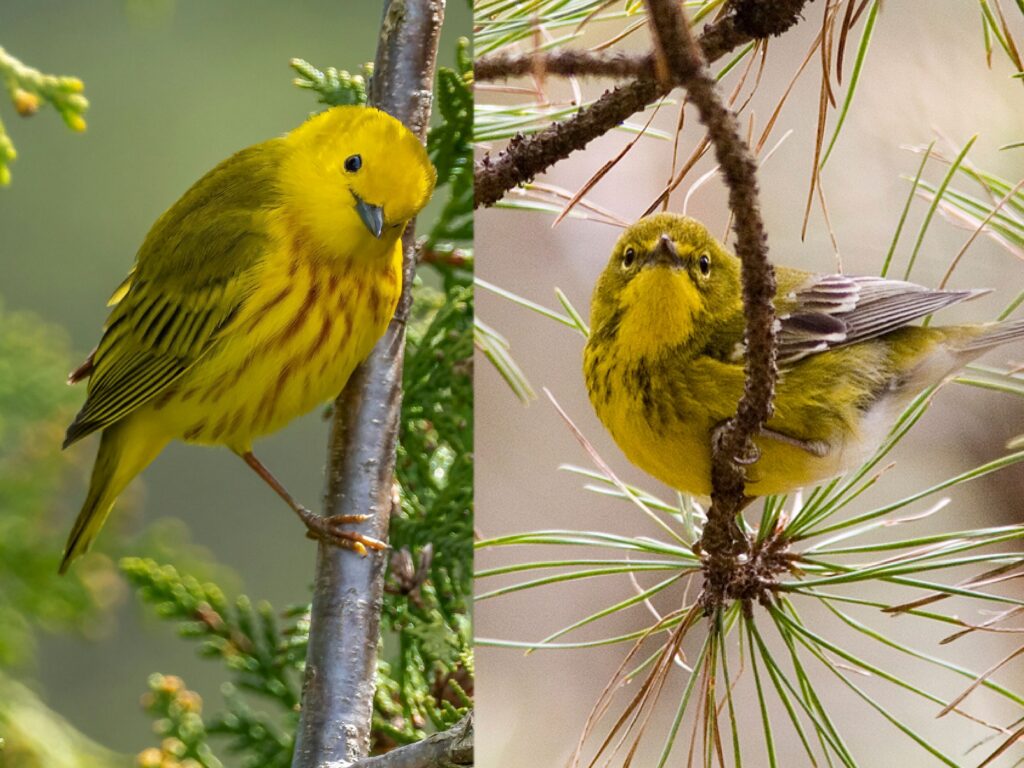
Left: A Yellow Warbler. Right: A Pine Warbler. Photo Credits: Patrice Bouchard (via Unsplash) and Fritz Myer
Sparrows
Unlike warblers, which generally each possess distinct coloration or plumage patterns, most sparrows you’ll find on your hikes will be shades of brown, will have some sort of eye line, and will likely have streaks on their bellies. Dark-eyed Juncos and Eastern Towhees are an exception to this, but often you’ll have to rely on traits other than plumage to determine what you’re looking at. Size is useful for identifying Fox Sparrows (large) and Chipping Sparrows (small) but in isolation it can be challenging to place what you’re looking at in perspective with other sparrows you’ve seen. Thus, size is most useful when multiple species are present at the same time.
Habitat is also a clue – you’re unlikely to see a Swamp Sparrow in the heart of the Pine Barrens, after all! When it comes down to it, the most similar sparrows in terms of plumage, habitat, and size are the Song Sparrow and the White-throated Sparrow. Although the latter’s name might suggest a simple way to distinguish the two, this isn’t always the case. Juvenile White-throated Sparrows possess less distinct white throats, to say nothing of natural differences in pigmentation. Not every bird you’ll see out in the field looks like the picture-perfect specimen in your field guide or on the Merlin app. Thus, the most important thing to remember is that Song Sparrows possess very clear and distinct streaks on their belly, and often feature a single, most prominent streak on their centers. Additionally, White-throated sparrows migrate away from the Island during the warmer months, so if it’s the middle of July, you’re not likely to see them.
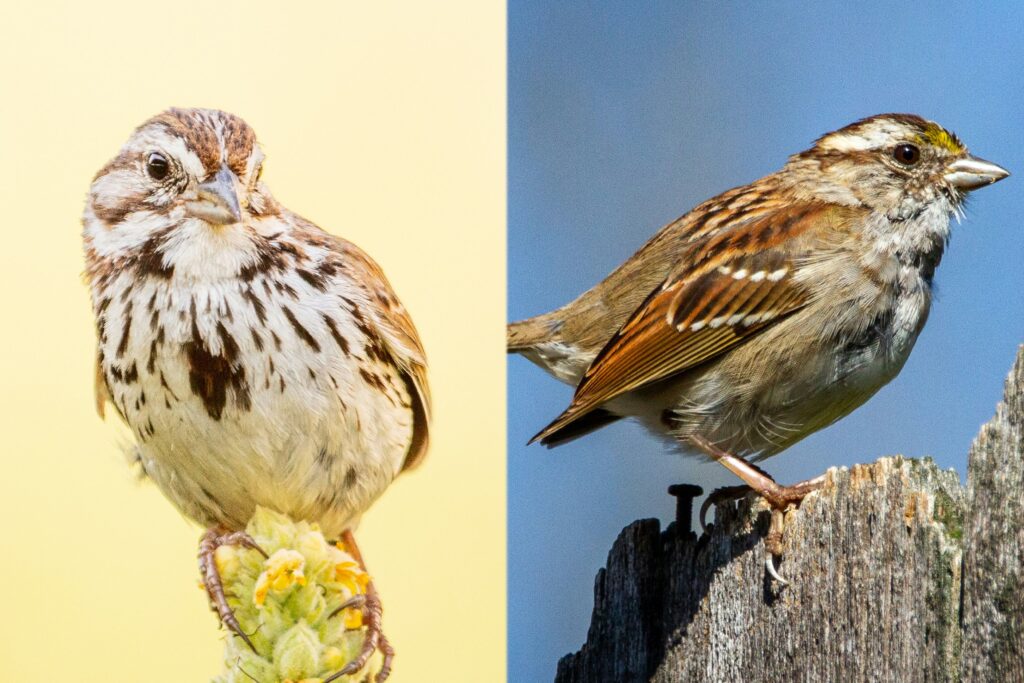
Left: A Song Sparrow. Right: A White-Throated Sparrow. Photo Credits: Matthew Schwartz and Joshua J. Cotten (both via Unsplash)
Hopefully this brief guide will help you to identify birds and enjoy this incredibly exciting and enriching hobby. From your own backyard to the Shoreham Forest, you can find birds of all shapes and sizes across Long Island, if only you choose to look for them. Happy Birding!
By Travis Cutter, Long Island Pine Barrens Society
Posted on March 20, 2024 by Long Island Pine Barrens Society
Finding a Seat in The Pine Barrens
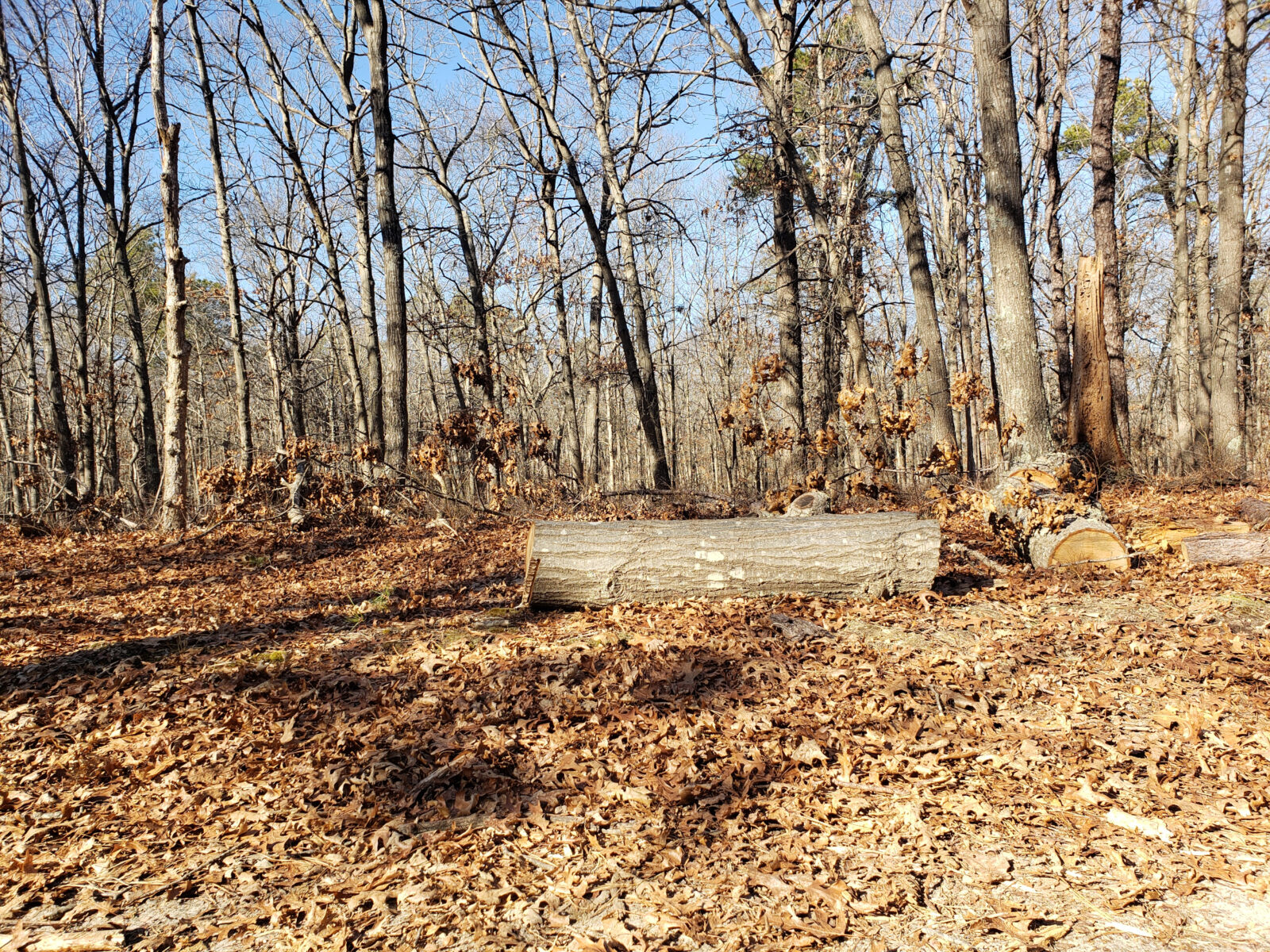
If you’ve hiked across the Island at all, you’ve probably noticed that seating options tend to range fairly widely across different parks and trails. Your average seating accommodation can range from a full-sized picnic bench to nothing more than the ground beneath your feet. If you’re not already an experienced hiker, going for upwards of an hour along a dirt trail can be tiring, regardless of the general health benefits. In these situations, finding somewhere to rest and take a break can be incredibly important to preserving your energy, and to prevent soreness the next day. So, we wanted to take some time here to go over some methods of catching a break on the seatless trails.
Push up against a tree
If you need a quick rest and there aren’t any benches in sight, your next best option is to take a rest up against a tree. Just having something to put your weight on can take a massive load off your legs, and a tree is perfect for that. It’s worth it to give the tree you choose a quick once-over for any bugs though, since you are about to be leaning against their home. If you’re on a more urban trail, there may even be railings or street signs you could do this with, though it’s unlikely that such a developed trail wouldn’t have a few benches along the way. Whatever you decide to lean against though, this method is ideal if you want to give your legs a short break without stopping completely.
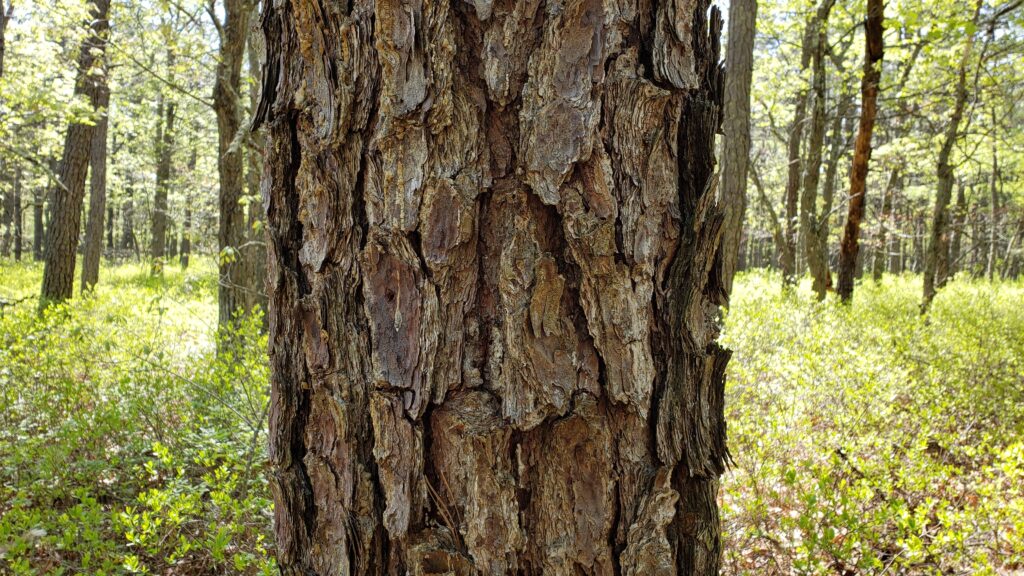
Bring a chair
This one is really more for those extra long trails on the Island, where you’re already going to be keeping a backpack full of snacks and water with you. Especially now, portable “hike chairs” have become more compact and reliable than ever before. They can get to be as small as 1 pound in weight and can easily fit into a backpack for those who need a more defined seat on their hikes. That said, this is the one option here with a fairly steep price. If you want a good chair that’ll last, it’ll cost you well over $100, and even the cheapest chairs won’t come in under $25. And frankly, if you’re going to be hiking such a long trail in the first place, you’re probably already used to going the distance, or at the very least sitting on the ground, and a chair will just take up space.

Photo by Zara Walker on Unsplash
Park yourself in the dirt
Desperate times call for desperate measures, and if you’re too tired to stand, there’s no shame in dirtying your bottom to take a rest. That said, you don’t want to park yourself just anywhere. Especially in warmer months, ticks will be abundant on LI trails, and the last thing you want is to get swarmed by them or other bugs when you sit down.
The best way to avoid ticks, and bugs in general, is to try and find as open a patch of ground as possible. No plants or branches, no grass, and if possible as few leaves as possible. That may sound like a description of the middle of the trail path, but you’d be surprised what corners you can find when you’re really desperate. That said, if you struggle to feel safe doing this, and know you’ll need a break along a benchless trail, it may be worth it to pack a small cloth towel to use as a ground cover. Flour sack towels are best for this, since they can easily fit into your pocket, and provide a fairly large surface to sit on. In colder months you could also use your coat or sweater for this, just be sure to shake it out before putting it back on!
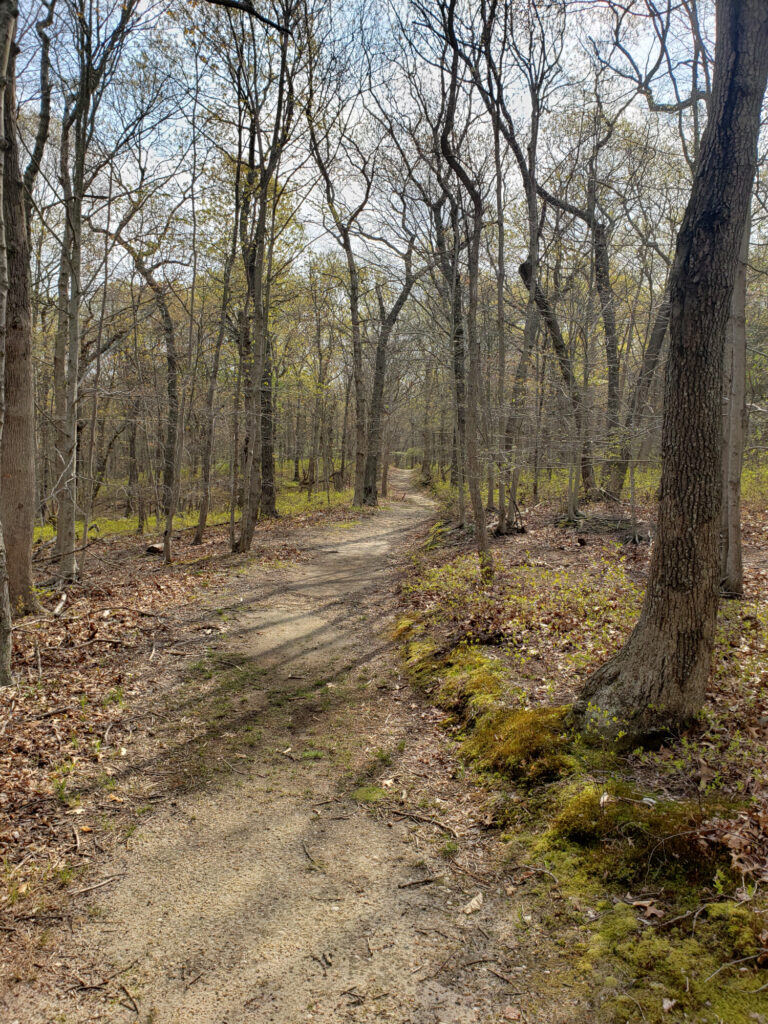
A fine bit of dirt
If all else fails though, and you find yourself needing to sit in an uncleared space with nothing between you and the ground, be sure to follow our guides for tick prevention and identification, check yourself as soon as you get up, brush off your clothes, and take a shower as soon as you get home, before checking yourself again.
However you choose to take a rest along the trail, it’s important to recognize your own limits, and to pace yourself with your hikes. If you’re just starting out and don’t have much experience on the trail, consider starting with a local green trail. These almost always have benches every few hundred feet, and are spacious enough that even in the worst case scenario you can just park yourself on the side of the path, well out of the way of other walkers or cyclists. If you’re really in the mood for a more rugged trail, pick a short one, and don’t dive headfirst into a 5-mile trail loop. Hiking has lots of benefits, both health- wise and in letting you see so much more of nature, but none of that is worth it if you’re suffering every step of the way. Hike safely, hike responsibly, and most importantly, hike at your own pace.
By Andrew Wong, Long Island Pine Barrens Society
Posted on February 20, 2024 by Long Island Pine Barrens Society
Climate Crisis on Long Island

If you’re in any way involved in environmental protection efforts, then you’ve already seen the news that 2023 was the hottest year on record in 150 years, or rather, the hottest year on record since we started keeping records of temperature. Those who haven’t seen this news already can find a plethora of articles from just about every major news publication, but we’ll just link the article from Reuters here. I doubt anyone reading this needs any convincing as to the severity of the climate crisis, so I won’t bother going over the broader aspects of it. What I think will be useful though, is just how this is currently affecting, and will continue to affect Long Island in the coming months and years, so that you can be informed, and so that you can inform others.
Not Retreading Old Ground
The LIPBS has already published an article on how climate change affects the Island, and if you want to do so you can read it here. The points covered can, now, seem almost simple in how normalized they’ve become. Even if it’s not a hurricane we’re dealing with some manner of destructive storm almost every month now, even just this month! The problems listed here are all still happening, but most have already accelerated, or been worsened.
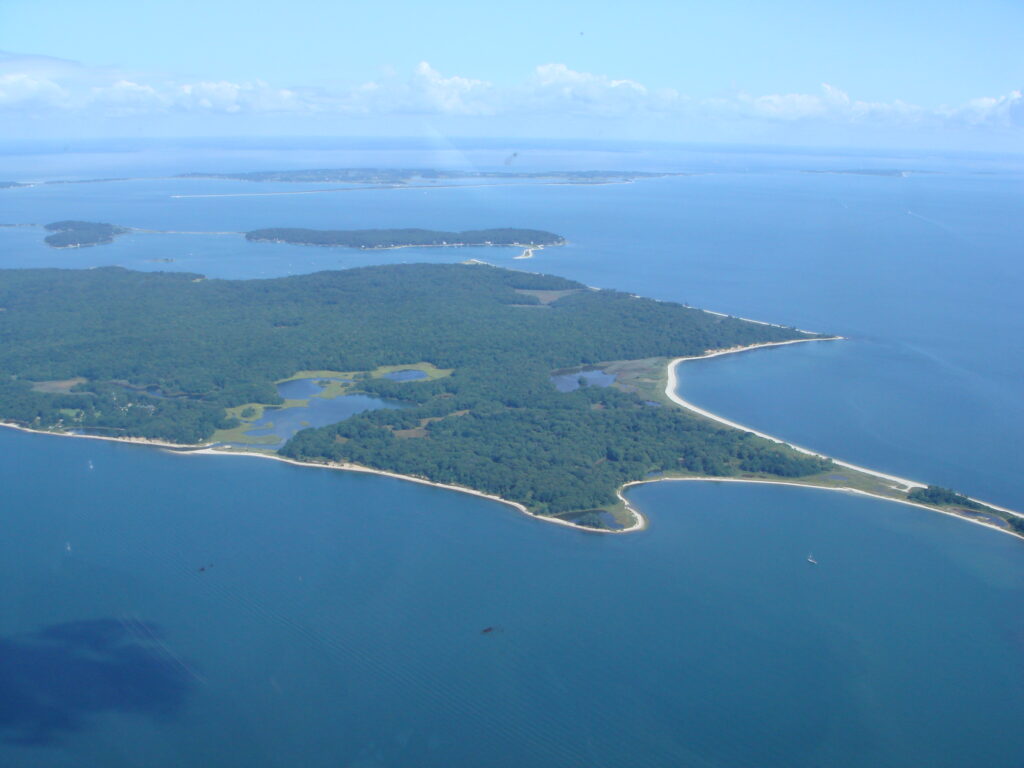
Photo Credit: DEC Helicopter Survey
We’re not here to discuss what we’ve already gone over, and we’re certainly not here to reiterate points all of us already know, so we’ll be leaving this article alone for the time being.
Droughts and the Aquifer
While we were able to avoid a severe drought last year, most of us I think were somewhat caught off guard by the 2022 drought, which came with a while host of recommendations from the water authority to reduce our usage. Of course, 2022 was just the culmination of a series of droughts stretching back to summer 2020, with 2023 being the exception to this. Droughts have, of course, been ongoing on the Island since 2016, with subsequent years only intensifying an issue that was once far from our minds.

Photo Credit: Anton Ivanchenko via Unsplash
When our life here on Long Island is already so dependent on what little water resources we have, droughts occurring so frequently are an issue we cannot afford to ignore in any capacity. This is, of course, not even considering the already occurring contamination of the aquifers, making this at-risk resource so much more delicate. Seawater contamination is at the forefront of this, where rising sea levels and constant droughts only serve to further intensify the problem. Then there is the issue of pollutants entering the ground, which is an entire can of worms itself that could take up an entire blog all on its own. The danger of a drought is very real and is contributing to an issue that only our grandchildren will live to see. Long Island losing its clean source of water is now a very real threat that many of us may very well live to see.
What have we been doing about it?
Issues like this are quickly reaching a point of being too much to handle, but what can be done at this point? For decades, every environmental group has called for these issues to be addressed at a legislative level, yet for every victory, it comes with a plethora of losses. Even the Pine Barrens Protection Act, which marked such a massive victory in 1993, today is sometimes little more than a suggestion to big developers like Discovery. So then what course of action remains, if even our greatest victories are sometimes compromised?
Consider the decades of nonviolent action that have failed to produce results the next time you hear about an activist acting out in front of a government building, or about the interruption of some awards you looked forward to by people screaming in the planet’s name. Consider the fact that the very first widely reported eco protest happened 54 years ago, and how we’re on an even faster course to environmental destruction now than we were then. That for all our peaceful efforts, the forces that are polluting our water and planet have more power today than they ever have before. It’s easy to distance yourself from the most extreme protestors and advocates, who are willing to put their livelihoods on the line so easily for their causes. Even easier than to condemn their actions as too extreme, or the wrong way to do things. But when the right way of doing things has gone so long not only without results, but with a constant downward trend, then what reason is there to continue doing things the right way?
The environmental movement has a long history of victories, but very few of them directly affect the quality of life for the people around it. Despite the researched and confirmed health benefits of living in or around green areas, a lovely trail does little to help those living in poverty. It’s only in recent years that the topic of Environmental Justice has come closer and closer to being a core part of the movement. Environmentalism as a cause cannot survive so long as it tries to push itself above more ground level social causes. As long as housing inequality exists, as long as income inequality exists, as long as race inequality exists, and as long as our economic system rewards the rampant destruction of the planet, no lasting change will be made. As social justice movements expand and move towards the future, the environmental movement needs to move with them, lest we be left behind in the dust.
By Andrew Wong, Long Island Pine Barrens Society
Posted on January 30, 2024 by Long Island Pine Barrens Society
LIPBS 2023 Wrap Up

Last year we held a yearly wrap up on our social media accounts. It was an enjoyable way for us to recount the year’s events in an episodic way, highlighting a different event each week leading up to the New Year. This year we wanted to do something similar, but here on the LIPBS website instead! This way, you can binge through all our highlights from this year at once, instead of needing to wait a week to get your fix of the LIPBS!
Let’s open this with our big event from the summer, the 30th Anniversary Celebration of the Pine Barrens Protection Act! Or rather, the 30th Anniversary Celebration of the *Signing* of the Pine Barrens Protection Act. Our event was held in the very same Southaven County Park where former Governor Mario Cuomo signed the act into law in 1993. There, the founders of the LIPBS were joined by current staff, as well as supporters and locally elected representatives, all to celebrate the anniversary of the landmark act.

Credit: Wayne Cook
At the event we reminisced about the past, but also looked to the future with our “The Best of The Rest initiative,” which has currently brought approximately 900 acres out of the desired 3,800 to the appraisal/negotiations/acquisition table. Playing between speakers, was the very same band that played at the original signing in 1993, a but older, just like the rest of us. The entire event capped off with a guided hike around the park from Society Board Member, co-founder and renowned environmentalist John Turner.
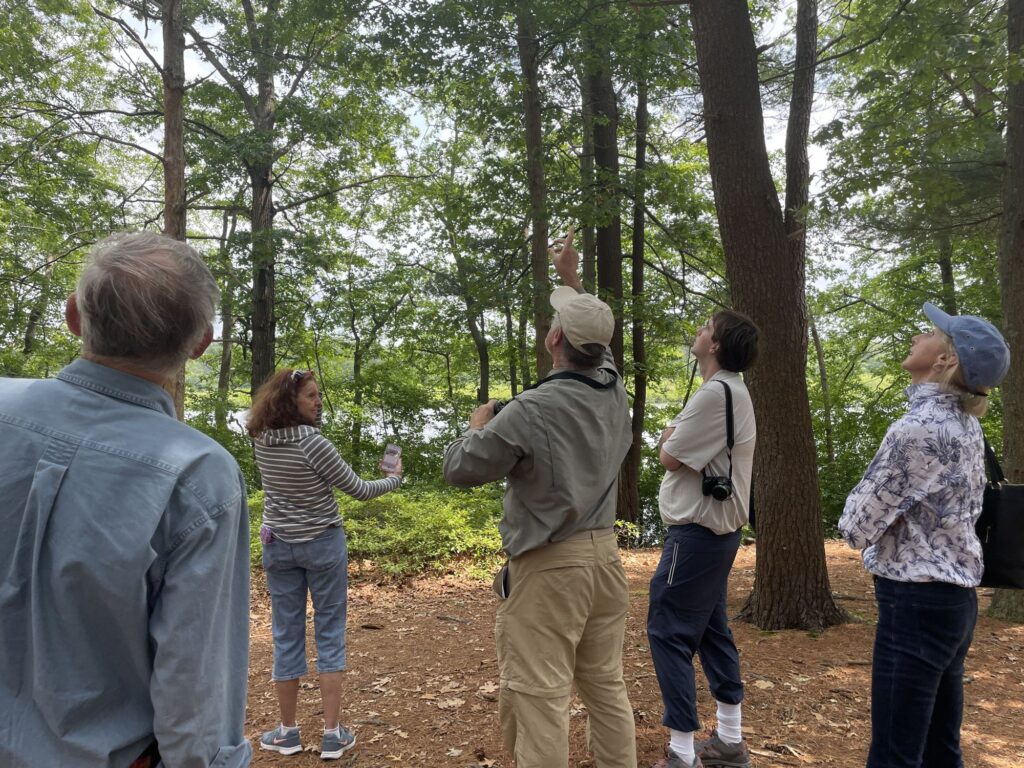
Credit: Dylan Eiden
Also at this event was the awards ceremony for our Middle School Kids Go To College program, which was held a month prior. For the first time since 2019, the college component was live, held at Stony Brook University, on the SOMAS campus. There, students from three Patchogue-Medford middle schools were treated to a lecture from Dr. Chris Gobler, a world-renowned scientist, and professor at the university. Dr. Gobler went over the water-related issues plaguing Long Island, as well as some of the solutions which have been put to work over the last few years.
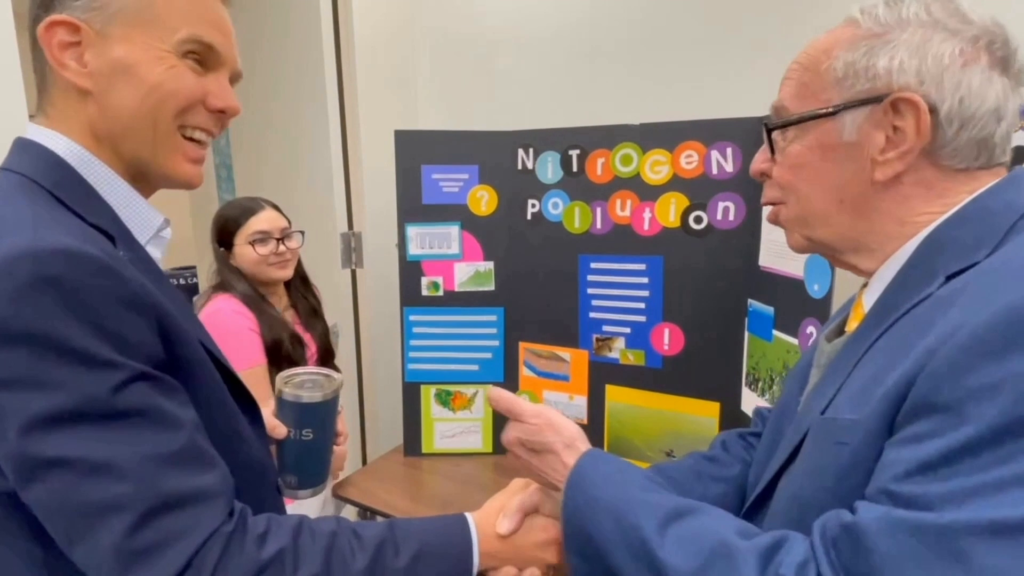
Credit: Dylan Eiden
Once Dr. Gobler finished his presentation, it was time for the students to put on presentations of their own, showing off their own projects, which they had been researching and preparing for months before. These projects differed from student to student, as observed by both Dr. Gobler and the LIPBS staff. After the event had concluded, the Society staff took their time reviewing the projects, before selecting just a select few to be presented with awards at our summer celebration.
And speaking of celebrations, we once again hosted our yearly Gala in October, this time marking the 46th anniversary of the Society. This event was focused largely on recapping the two events we just went over, but did come attached with our ever popular Silent Auction, with a host of getaways and restaurant trips included as the incentives.

Regardless of what big events we hosted this year though, our focus has remained on securing parcels through “The Best of The Rest.“ Progress has been steady since we began, and we are on good pace to ensure that Long Island’s open space will stay preserved for generations to come.
By Andrew Wong, Long Island Pine Barrens Society
Posted on December 19, 2023 by Long Island Pine Barrens Society
Sharing the Road
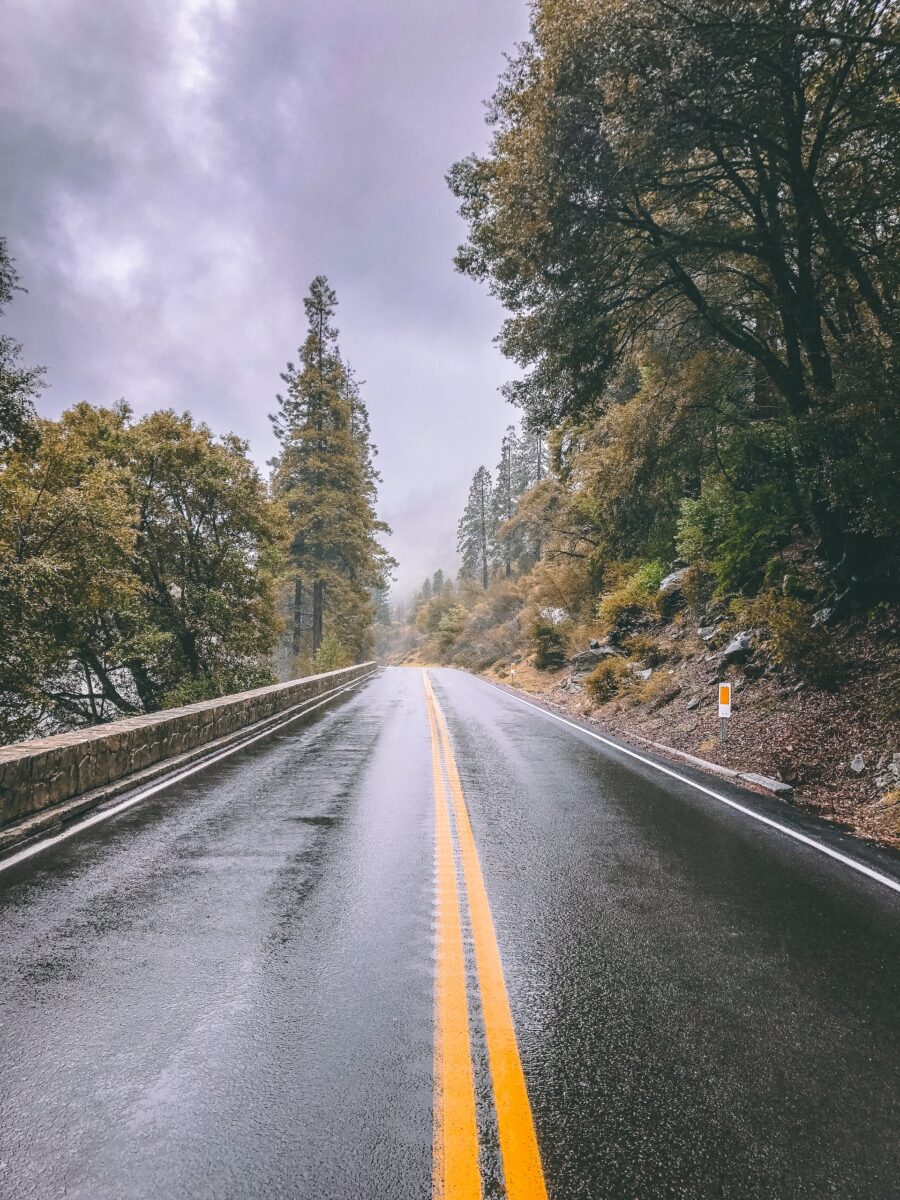
As anyone who’s ever had to take a back road on the north shore can tell you, Long Island has an abundance of wild turkeys. Around now they can be a bit of a festive sight to see crossing the road, but any other time of the year it can be a bit stressful to see these big birds loitering in the middle of the road. You really don’t want to hit one of these birds while they’re just hanging out so you might find yourself just sitting and staring at them for a few seconds, waiting for them to cross the road. This isn’t an experience unique to turkeys though, as plenty of us have probably had one or two scares when a deer jumped in front of us out of some brush.
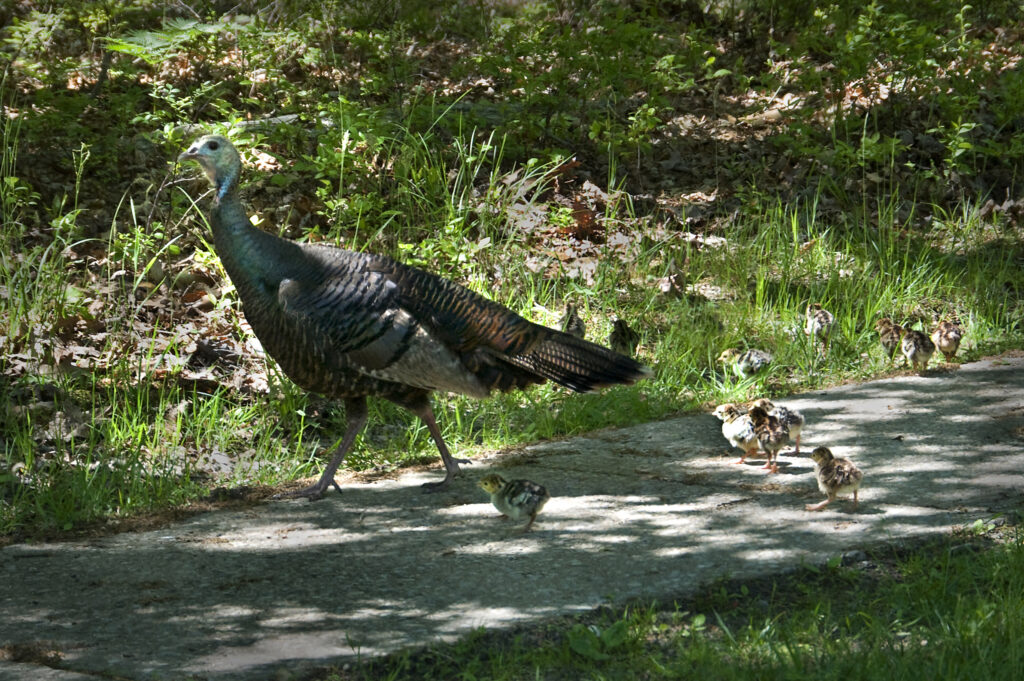
Credit: Brookhaven National Lab
In general, avoiding these big birds can be a challenge, especially because of how well their dark feathers blend into the color of the ground and trees. This, combined with just how calm turkeys tend to be around humans, makes them a real risk on the road. So, be sure to practice basic driving safety, eyes on the road and all, but even then there’s a real chance you might not see a group of turkeys until you’re just a few yards away from them. In these sorts of cases, assuming you’re going the speed limit, combined with how low that limit is on most back roads where you’re likely to encounter a turkey, a sudden stop should still be perfectly safe.
Of course, if you’re going well over the limit, or maybe on a road where the limit is much higher, a sudden stop can be dangerous. Tempting as it might be to swerve out of the way of a pack of birds, the sad reality is that a turkey is a whole heck of a lot softer than the trunk of a tree, and if there’s not ample road, you’re a lot better off not risking a hospital trip over a couple of them. This is of course, a last resort scenario. Ideally you’ll either be going the speed limit, or have enough road that a higher speed swerve won’t take you off the road. In any other situation though, it’s important to place the safety of yourself and your passengers first.

A beautiful bird, but not worth your life.
All of this is magnified in hazardous weather conditions. If there’s heavy fog or worse, heavy rain, then the odds of you being able to see anything in front of you, much less something rushing out of the brush, is low. If an unfortunate turkey or deer jumps out in front of you trying to make any evasive maneuver, even going a reasonable speed, will put you and other drivers at risk. If you do happen to hit something in hazardous weather, it’s important not to stop driving, or to look behind you to assess damage done. If you want to check on the wildlife you collided with, gradually slow down, and pull over some distance ahead. Stopping suddenly or taking your eyes off the road puts everyone in danger, and you should only go to investigate once you’re safely parked on the side of the road.
We realize this isn’t a particularly enjoyable conversation to have at any time of year, but with winter coming soon and recent bouts of heavy fog, it’s important to take all possible measures to keep yourself and others safe on the road. We all love our wild neighbors on the island, but if the worst-case scenario happens, it’s important to place you, your passengers, and other drivers’ safety above that of the wildlife. An animal collision is tragic, but not as much so as a car driven into a tree or home.
By Andrew Wong, Long Island Pine Barrens Society
Cover Photo by Matt Foster on Unsplash
Posted on November 28, 2023 by Long Island Pine Barrens Society
Splash: Clean Water Now Recollection

Last week, we hosted our 46th Annual Environmental Gala! There was quite a leadup to the event itself, and after a live broadcast on Facebook and a Premiere on YouTube, everyone at the Society got to breathe a sigh of relief. In case you missed the Gala, you can watch the full video now on YouTube! But, in case you were looking for something more newspaper adjacent to go with your morning Coffee, we’ll also be summarizing it here!

A Lot of the footage for this year’s Gala actually came directly from our Summer celebration of the 30th Anniversary of the Pine Barrens Protection Act’s signing! We covered that whole event in a separate blog post back over the summer, but we’ll run it down quickly here. Opening speeches from Executive Director Dick Amper and Society Board Member Tom Casey opened the event, with kind remembrance of the work done and some light humor. After they got their words in, a number of local politicians took the stage to recount their own experiences with the Pine Barrens Protection act, and where they were when the Act was passed. This section of the Gala was closed out with some music from the Sunnyland Jazz Band, the same band that played all those years ago when the act was first signed!
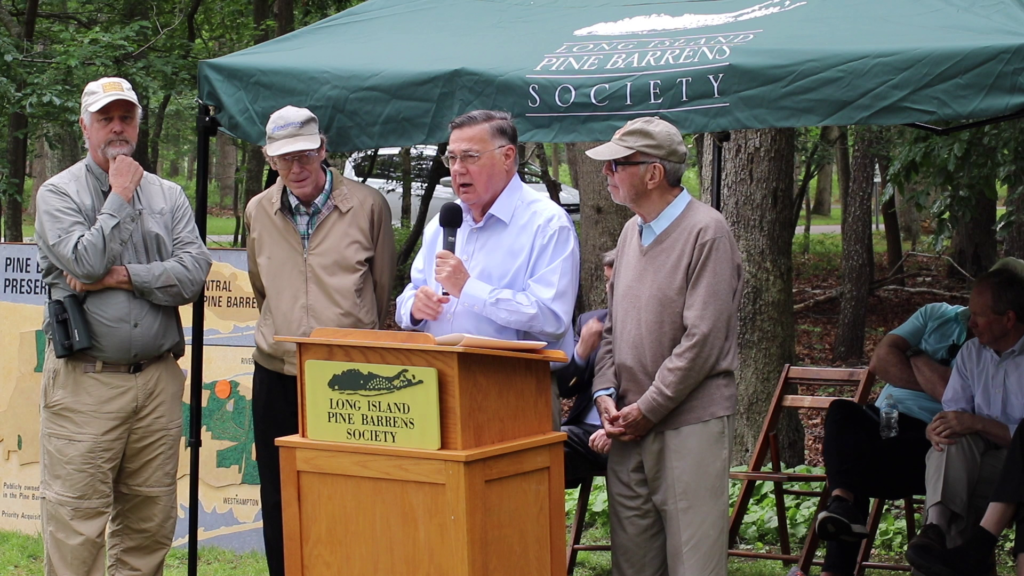
John Turner, John Cryan, Ed Romaine, and Dick Amper
The next section of the Gala was a recounting of our yearly Middle School Kids Go To College program, with a brand new video produced just for the Gala! In it, We showed off some of the event itself, from our grand assembly of 3 different schools at Stony Brook University, to our individual visits to each school, you’ll get to see every bit of the program right from the comfort of your home! Once we were done at the schools, we went back to our 30th anniversary celebration to present individual awards to some of the winning students!

Dr. Christopher Gobler and Dick Amper
Finally, the event closed out with an important presentation by Society Board Member and environmentalist John Turner on our new initiative, The Best of The Rest. In his presentation John covered all the different parcels we’re still fighting to preserve, as well as the various flora and fauna which inhabit the parcels. Not naming this year’s gala after the initiative doesn’t mean we’re pushing The Best of The Rest any less, and we’re always working behind the scenes with local government and other non-profits to try and secure as much of the land for preservation as possible.
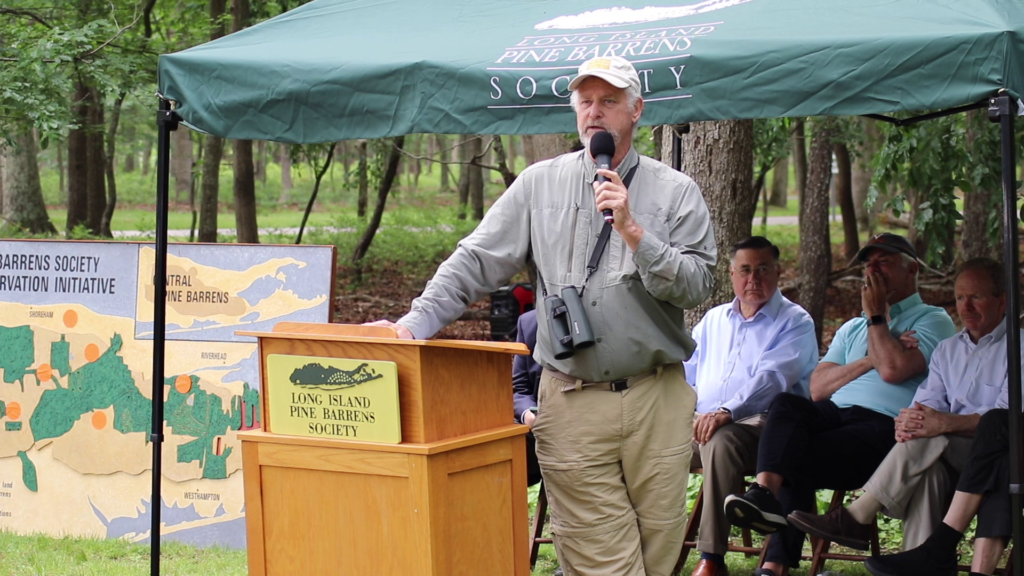
John Turner speaking about The Best of The Rest
And with that, our Gala was closed out by Executive Director Dick Amper, before shifting into some highlights of our special Silent Auction (which may or may not be over by the time you read this). The Gala season is, to put it lightly, a bit of a busy time for us, but every bit of the work we do is worth it to share with people our continual progress and history.
We hope you enjoyed watching Splash: Clean Water Now as much as we enjoyed putting it on. We’ll see you next year for our 47th Gala!
By Andrew Wong, Long Island Pine Barrens Society
Posted on October 30, 2023 by Long Island Pine Barrens Society
Water We Gonna Do 2023 Edition
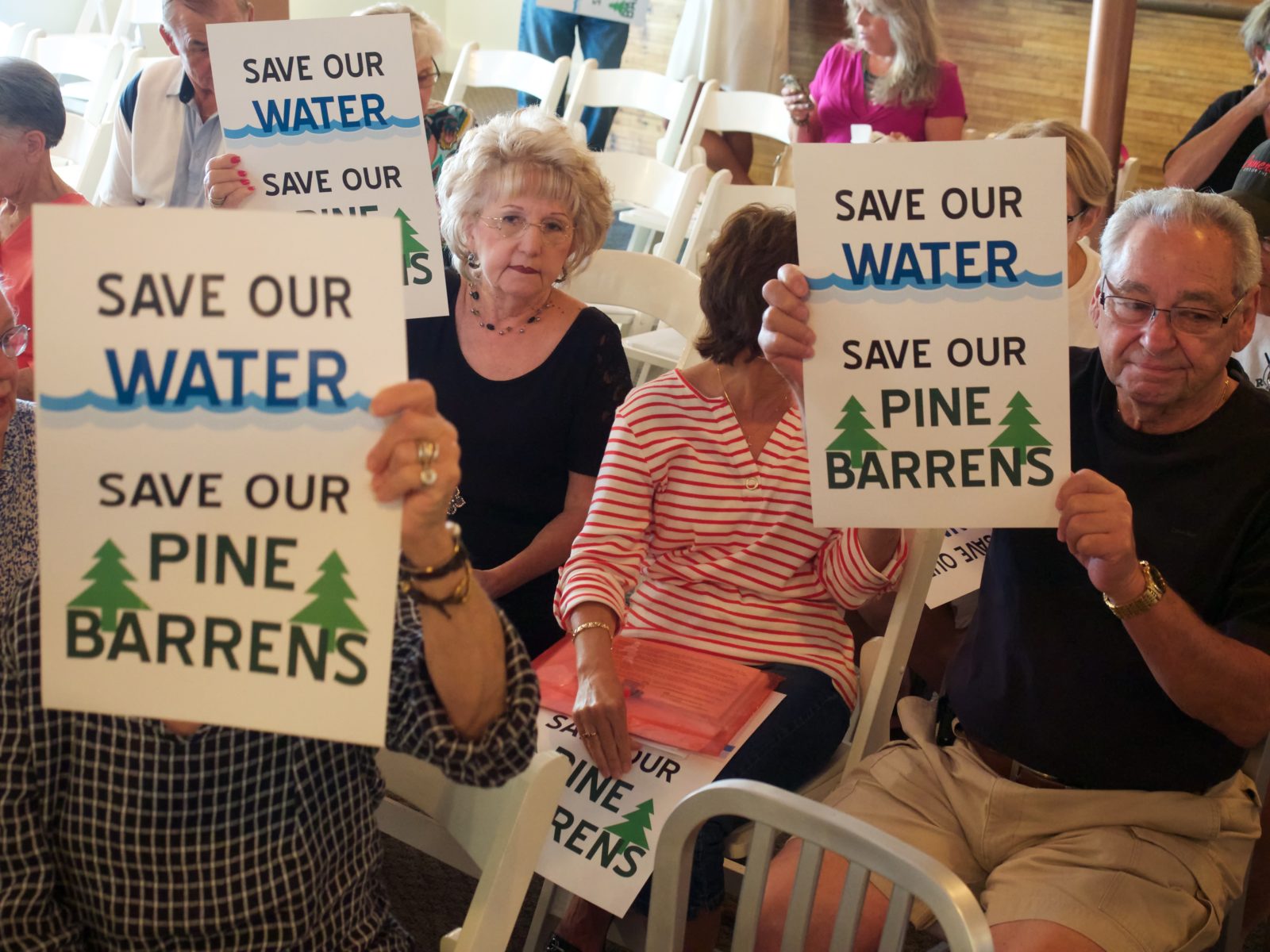
The topic of water quality and quantity is very much so central to the LIPBS’s core mission. If the Pine Barrens themselves are our bread, then the underground aquifer is our butter. Protecting Long Island’s precious aquifer has always been the goal as much as protecting its precious forests, but that focus on water becomes more and more important with each passing year.
Recently, an article published in the New York Times highlighted Long Island’s water problem, as just a piece of a greater issue happening across the country due to overuse. The article is hardly an enlightening read if you’ve been paying attention for the last few decades, though it’s sobering regardless. While the article is paywalled on the NYT website (unless you are a subscriber), it can be read for free through the internet archive, a free online library (the formatting is a bit messy though, so you’ll have to scroll down a bit to find the main article).
The article, in its entirety, confirms one thing that should come as no surprise to Long Island environmentalists. One of the largest obstacles to better regulations for our water supply is overuse and contamination by for-profit organizations and companies. Right here in Suffolk County, the County legislature has not let resolutions advance so that residents could vote to incur a slight sales tax increase to ensure clean water! Another issue is loss of open space for water recharge. While the article highlights industrial farmer associations as a significant opponent, Long Islanders will be much more familiar with land developers being significant opponents to better regulations. And then there are golf course owners, with their “need” to overuse their sprinklers to keep a palatable green grass across the course.

The excessive amount of water “needed” to maintain a golf course
If it’s not some sort of for-profit organization though, it’s the government itself highlighting profit over people’s lives, with one of the interviewees claiming that “If we start showing that kind of data, that kind of goes into your property values,” a quote from Oklahoma’s own Water Resources Board as to why data on water quality was not conveyed directly to homeowners. The mere potential for future tax dollars was enough to deny people the right to know that their drinking water was drying up. This is hardly a new problem anywhere though, corporations and government putting profit over lives has long been a staple in areas like Southern Philadelphia, where an oil refinery was able to operate for 150 years, poisoning the local residents and workers with cancer causing smoke and runoff. Despite decades of protests from local residents over the very obvious health risks posed by the refinery, no government intervention ever occurred, even with generation after generation being led to either early graves or livelong complications. The refinery was only ever shut down when its own safety violations compounded, and resulted in an explosion which even further poisoned the local residents, who still have not been offered justice in the wake of their century-long fight.
Such instances, when put alongside the constant fight across the nation by environmental groups, highlights the deeper root of our water issues. More so than any one person might waste a few gallons of water by taking a 20-minute shower, or more so than one person can contribute to the pollution of the ocean by forgetting to recycle a can. The root of these threats to our water, and our land, have always, at their core, been the for-profit nature of corporations and government inaction.
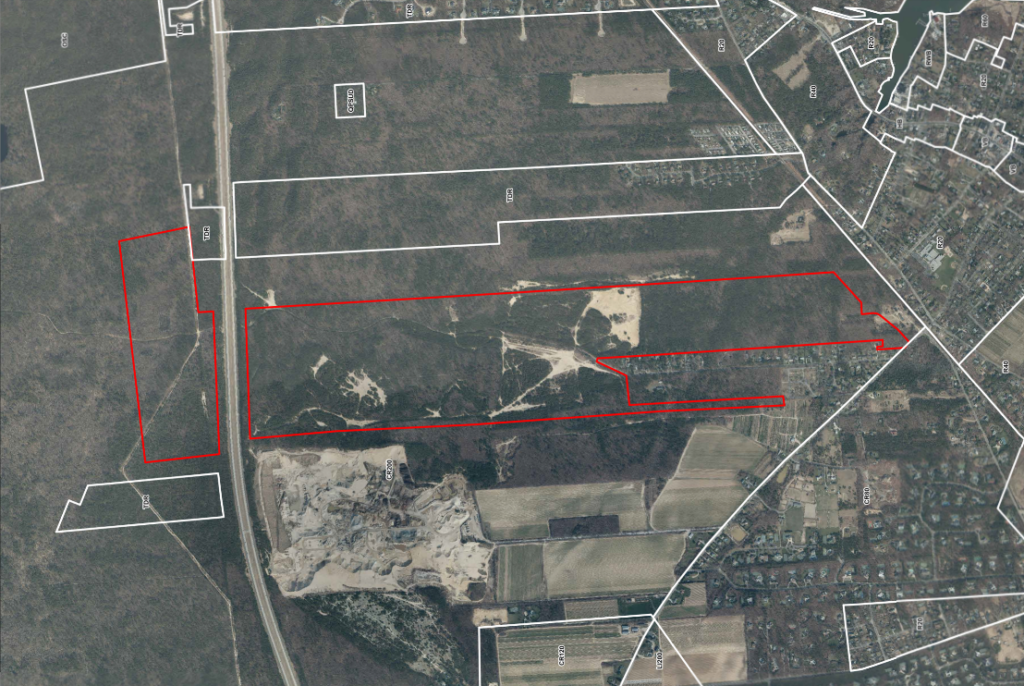
The Lewis Road PRD Project, one of many developments targeting our land and water
For over 40 years now Long Island has been under constant threat from both of these groups. Corporations and developers who have been poisoning our water as far back as the first suburbs, and government that refuses to act even when given the resources, highlighted as far back as the Suffolk Country Sewer Scandal, and now recently when Suffolk Country tried to steal millions from taxpayers by using money for general operations meant for water quality improvements.
Change and recovery, as far off as they may seem, are entirely possible. However, it will take more than just turning off our sprinklers or taking shorter showers to achieve it. It will take changes from the ground up, on a far deeper level, that can only be achieved through proper large-scale reform. Reform that is already being fought for by innumerable different groups on the ground, that require support to continue their causes. The work we and those other groups do today is done on the hope that 50 years from now, future generations will not have to do the same.
By Andrew Wong, Long Island Pine Barrens Society
Posted on September 25, 2023 by Long Island Pine Barrens Society
Rewilding: What it is and How to Do it
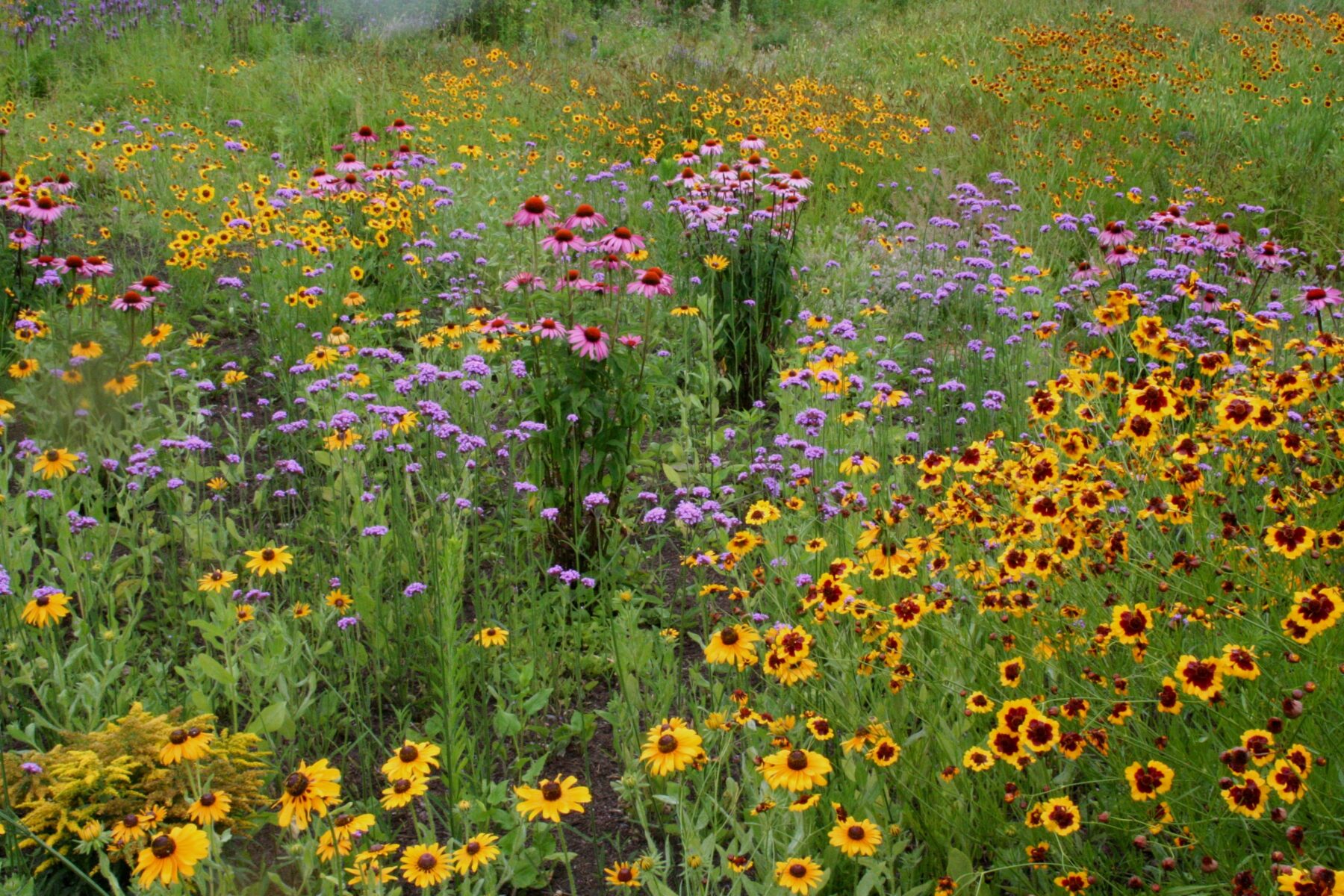
Summer has nearly come and gone; did everyone get to have some fun out in the sun? Even if you didn’t, hopefully you were able to see some of the bright green trees from out your window! There’ll be even more beauty to catch from the comfort of your home in the fall, but for now we’ve got other matters to press.
Back when Spring first came into bloom, we made a few posts on our social media advising folks to cut back on their sprinkler use during the season. We mentioned that, even though we all enjoy a nice green lawn, there’s ways to have it while saving water. But what if you don’t enjoy having that lawn? What if it’s actually a bit of an eyesore? What if the stench of chemical pesticides sprayed on top of it every time your neighborhood landscapers come through is starting to get to you? That last part might be a bit of a projection, but the point remains that if you’ve got space in front of your home, there’s a million things you could do with it that’d be prettier, and better for the environment than a lawn. The process of pulling up that lawn and replacing it with something just a bit more helpful to the local ecosystem is called Rewilding.
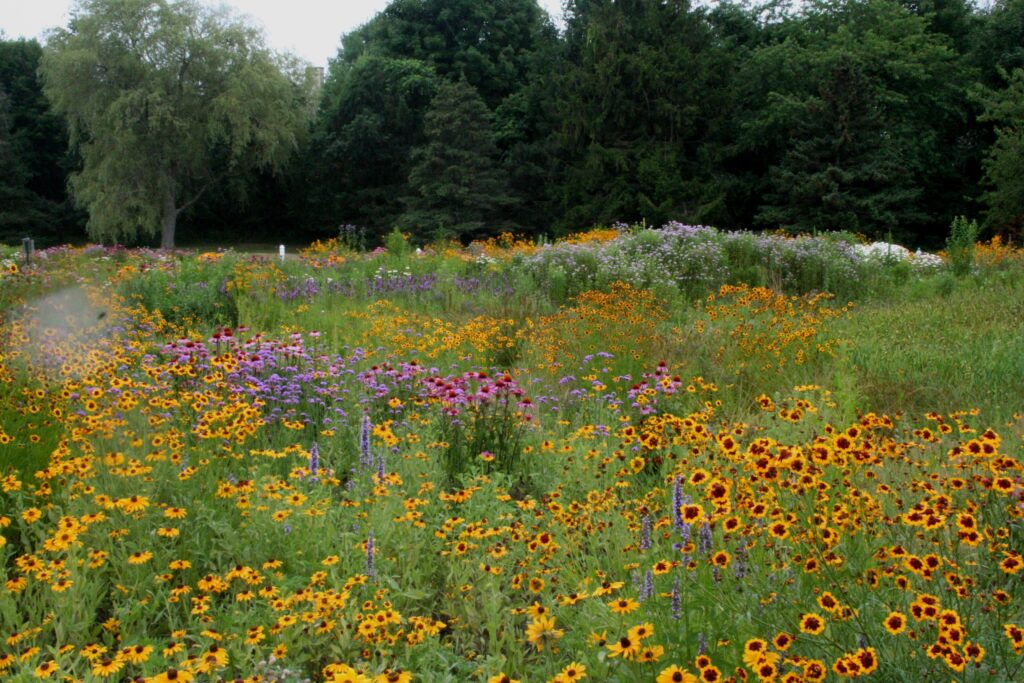
What is Rewilding?
Rewilding is something of a blanket term that can refer to a number of processes, but for our sake today, it’s the process of replacing a lawn with local and native plants to support pollinator colonies. A lawn has just about one use and it’s to look nice for a HOA, not even local deer can enjoy munching on it with all the pesticides they tend to need. Rewilding then seeks to use all that wasted space to create a miniature ecosystem right in your front yard, utilizing local flora to attract and support local pollinators as well as some of the bigger fauna on the island.
Rewilding is also something entirely different to just leaving your lawn to grow unchecked. Letting the kind of grass most of us have just grow without trimming is an open invitation for ticks and mites to settle into your yard, which none of us want. Rewilding is instead the process of completely removing your lawn, so that the space can be used more efficiently.
By planting small shrubs and flowers where there was once a lawn, pollinator species will have a much easier time gathering the resources they need to survive and thrive, though it’s important to recognize that bees aren’t the only pollinators on the island. Wasps, hornets, and even flies all pollinate different plants on the island too, and if you don’t want whole swarms of them in your yard, it’s important to pick your plants and seeds carefully, and to know which are pollinated by what.
How to Start.
The very first step to rewilding your lawn is to check if you’re even allowed to do so. Those living under especially restrictive HOAs may not be permitted to have anything but a ½ in cut lawn in their front yard, and we’d hate to leave any of our supporters with fines (unless defying your HOA is a hobby of yours, in which case stick it to ‘em). Certain communities may also share a contract for landscaping services, which you’ll want to get yourself out of as to avoid damage to your new yard.
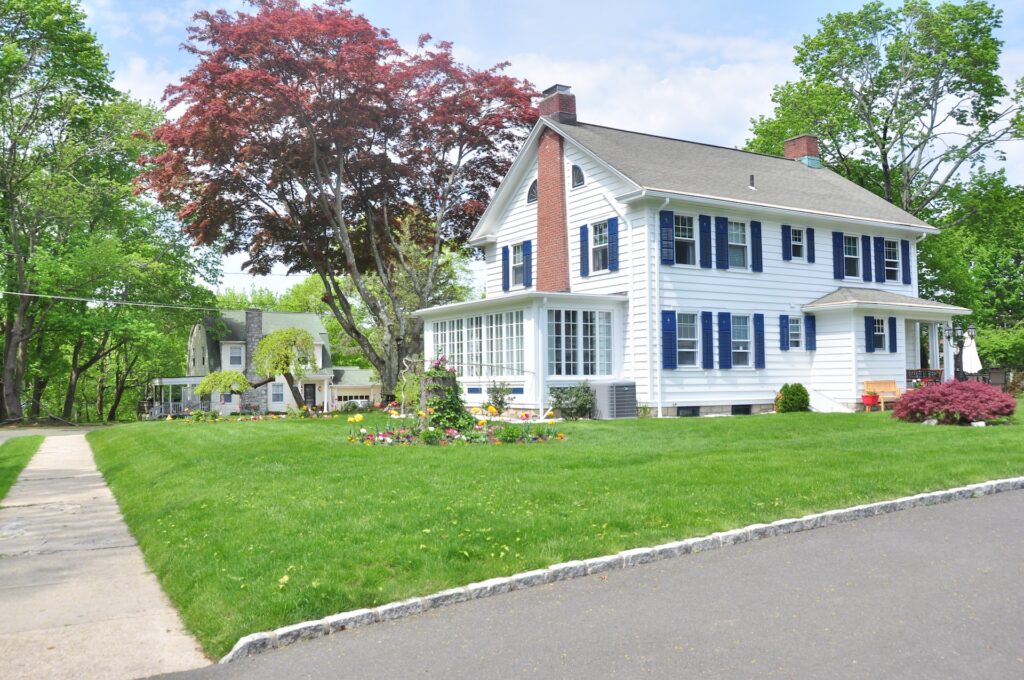
Your typical lawn with some flourishes
Photo by I Do Nothing But Love on Unsplash
Once you’ve cleared the prefatory hurdles though, you’ll need to start removing the lawn. There’s not exactly a single species of grass shared by the suburban nightmares of LI, and if you didn’t plant your lawn yourself, you’re not likely to even know what kind of grass you have. That said, no matter your grass, removing it is a fairly simple process. In fact, if you already contract landscapers for lawn care, you can likely just pay them to remove your lawn if the process is too much of a hurdle for you. If you enjoy having your hands in the dirt though, a tool like a tiller or sod cutter won’t exactly make short work of it, but it’ll be a lot faster than doing it with a shovel.
Planning it out
The next step before going any further, is getting a rough idea of how you’ll want your new yard to look. Consider taking some photos of your yard, or grabbing one off of google earth so you can have an easy diagram to work with and draw over. Consider what plants you’d want where, consider walkways or any decorations and where they would go. Maybe even consider going for a theme with it! There’s a lot you can do with a green space when you’re not worried about that 1 inch limit, so get creative with it and try different ideas!
Once you have a layout decided, it’s time to actually buy your new plants. Every plant you get for your yard should be native to your area, in our case Long Island, so that the local pollinators can benefit from it. There’s a lot more to consider even when you narrow down the selection like that though. Buying seedlings or shrubs already grown will be the fastest and easiest way to reach your goal, but it’s going to be far more expensive. Seeds alone on the other hand will be a long process that may not bear fruit if you don’t have experience growing form seed. It can take years for some small shrubs to grow large enough to cover land after all. Ideally you would want to go for a split between the two in favor of seedlings. Knowing how everything will look and being able to see the spacing between everything will be important in the long run.
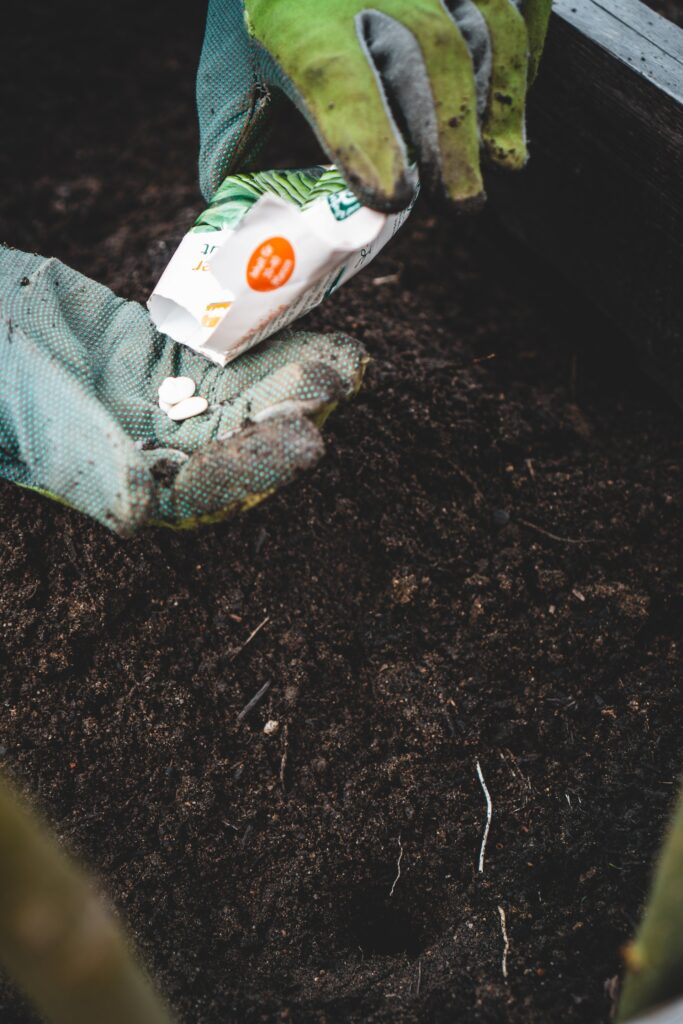
Photo by Jonathan Kemper on Unsplash
On the topic of the long run, this is very much so a marathon more than a sprint. Your new yard isn’t going to be the prettiest at first, especially if you’re more used to the vibrant green that a lawn typically provides. Especially in the winter months you’ll be dealing with an especially barren looking space, but given time and care you’ll find there’s so much more to be done with your space than we’re left to believe. Not to mention the space you’ll clear up by getting rid of that old noisy lawn mower.
Those of us privileged enough to own a home tend to waste the space we have much of the time. A clean and vibrant front lawn might look nice up against a dozen other identical lawns, but what does it do for us? The damage that pesticides and herbicides do just to keep a green lawn can be devastating to ecosystem, and that space is better used for quite literally anything else. We hope you will consider then the prospect of rewilding, not just as a way to beautify your space, but as a way to help support your wild neighbors on the island.
By Andrew Wong, Long Island Pine Barrens Society
Posted on August 23, 2023 by Long Island Pine Barrens Society
Staying Fashionable While Hiking
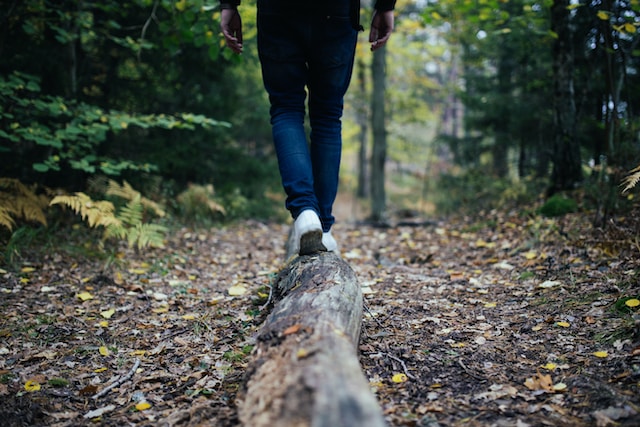
As much as a pair of sweats and a stretched out t-shirt may be one of the most comfortable outfits a person can wear, it’s hardly a stylish one. That said there’s certainly an argument to be made for the form over fashion benefits of an elastic waistband and breathable top. Such dilemmas can pop up all throughout our daily life, but looking good is not the most important in the quiet solitude of the wilderness. Will the birds judge me for having mismatched socks? Will the trees laugh at me for my color coordination? Are the ticks actually avoiding me because my pants are ugly? There are plenty of tips and tricks to keep yourself comfortable and coordinated on your hikes, especially in the summer months.
Keeping It Long
We’re no strangers to tick awareness here at the LIPBS, and we’ve made a few different guides to keep yourself safe on hikes, so we’ll just gloss over the basic dress code here. A long sleeve shirt, tucked into long pants, tucked into long socks. Minimizing skin exposure is always ideal but be sure to use repellant for the areas that can’t be covered. This will also help to protect you from cuts or scrapes should you pass through a particularly branchy area.
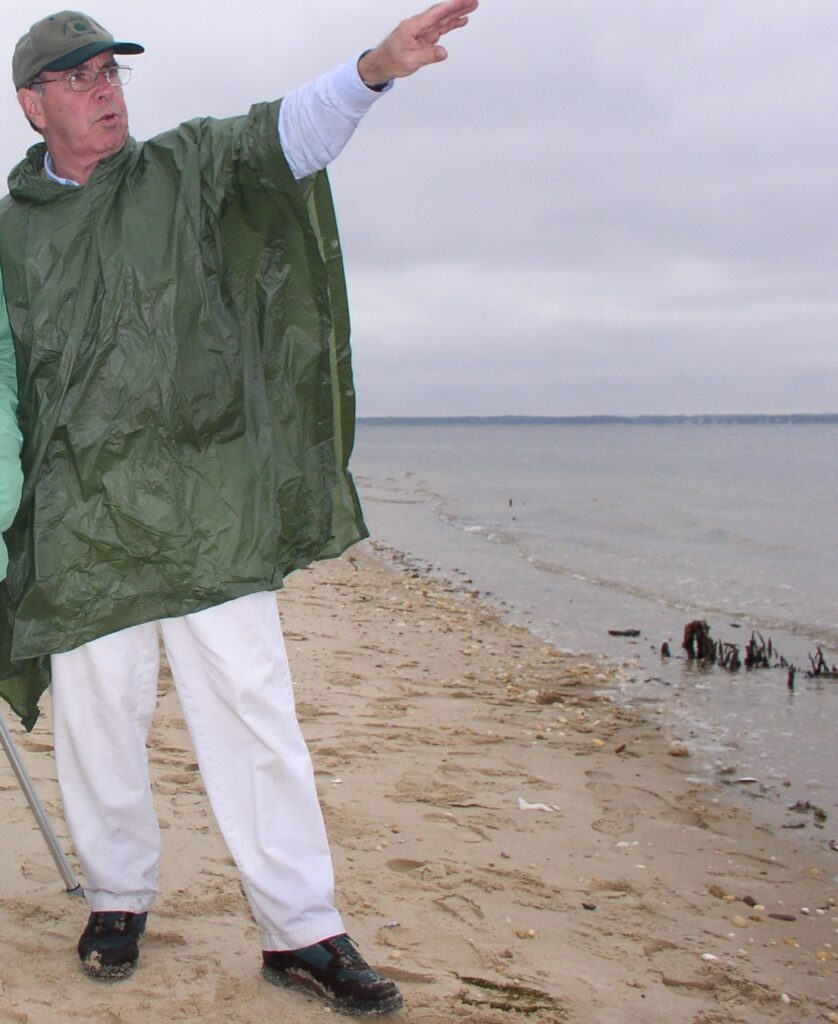
Society Executive Director Richard Amper wearing light colored pants on the beach.
Keeping It cool
Ok, so you’ve got your long sleeve long panted outfit, but it’s the dead of summer, and temperatures are regularly climbing into the 90’s, how do you compensate for that? Just as important as coverage is making sure that your clothes are breathable and light, which will typically come down to material. Nylon is the biggest contender. It is light, breathable material that easily stretches without deforming. A tight knit also makes sure nothing is going to get through.
That being said, nylon can get really expensive, really fast. Some of the top-rated nylon hiking pants can run you well over $100. Not to mention, nylon can just as easily be made to trap in heat given the right construction. You certainly wouldn’t want to go hiking in a pair of 100% wool pants, but there’s a wide range of materials that can keep you cool. When buying clothes for hiking, consider looking for the same style of clothes you might wear during a workout. Quick drying shirts and socks will keep you the most comfortable in high heat, but if you’re on a budget the socks will be the most useful in keeping you comfortable.
Keeping It Colorful
Just like with materials, the color of your outfit will have a big impact on your ability to stay comfortable in the heat, but there are a lot of other things to consider too. Lighter colors are best for our local Pine Barrens, beige being something of an iconic color for environmentalists, but any lighter shade will also be good. This is a two- sided benefit, for one, the lighter color will trap heat less easily than darker colors will, keeping you a bit cooler in the sun. On top of that, especially across Long Island, lighter colors will make it easier to spot and remove any ticks that may have latched on to your person during a hike. The pants are the area most likely for a tick to attach to though, so if you need to buy new and want to stay on a budget, focus there rather than on the shirt.

Photo by Charlie Hammond via Unsplash
However, when trekking outside of Long Island, or even on some of our more wild trails, you may want to be wearing some clothes that are more vibrant in color than plain lights. This is because, in the event of a worst-case scenario where you end up lost or missing, bright colors like red or orange will make it easier for people to find you in the brush. This is why you’ll typically see such bright colors on mountain climbers, who need to be easily identifiable against sheets of white. While our local Pine Barrens aren’t quite subject to the same conditions that would necessitate such color choices, you wouldn’t want to go hiking in woodland camo either way.
Keeping It Fun
No matter what choices you make based on the above, you should always prioritize comfort on a hike over anything else. Hiking should be a fun activity, and if you force yourself to wear stuffy or uncomfortable clothes just to follow one of these guidelines, then you won’t be enjoying yourself at all. Yes, long pants and shirts are important to keep ticks off, but even if a tick does bite you, it can be easily removed with a pair of tweezers with minimal risk to you. Yes, lightweight clothes and colors will keep you cool on your hike, but especially in the summer most of the Island’s trails are covered by a dense brush that will already keep you shaded for your hike. And yes, identifiable clothes can be important, but as long as you keep to the trails laid out on each hike, your risk of getting lost along the way is negligible.
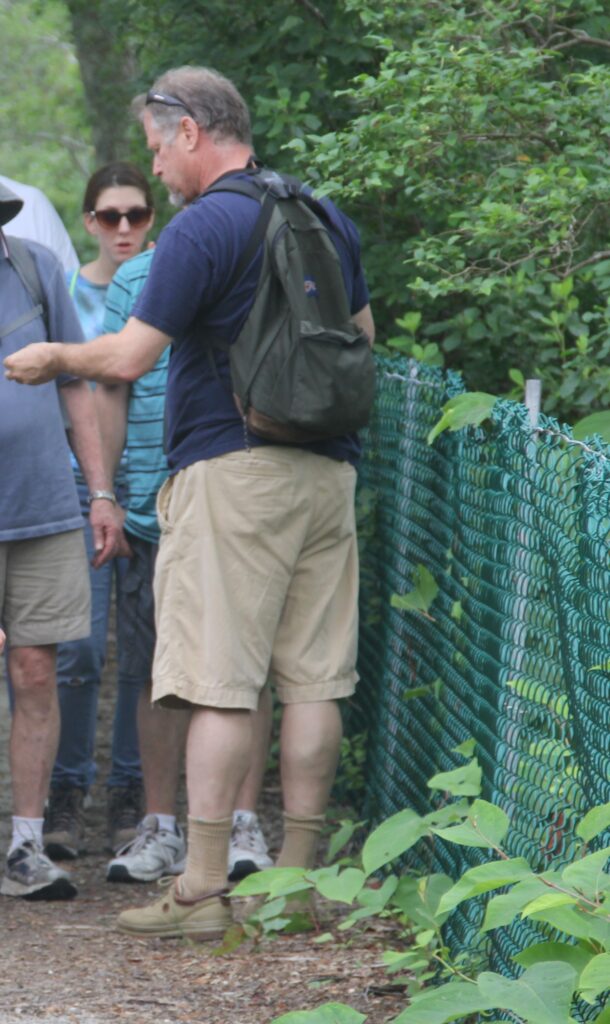
LIPBS Founder and Board Member John Turner leading a hike, not following any of the precautions we listed here
Hiking is supposed to be fun, so have fun! And don’t obsess over what you’re wearing too much, the trees won’t judge you, we promise.
By Andrew Wong, Long Island Pine Barrens Society
Cover Photo by Jon Flobrant via unsplash
Posted on July 20, 2023 by Long Island Pine Barrens Society

